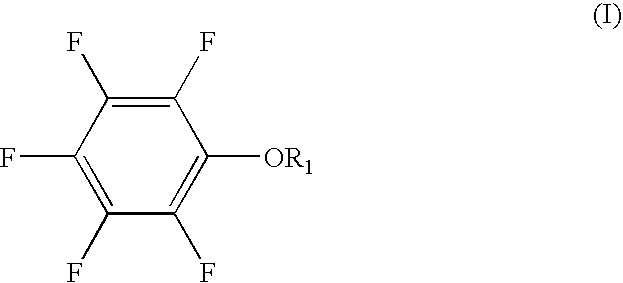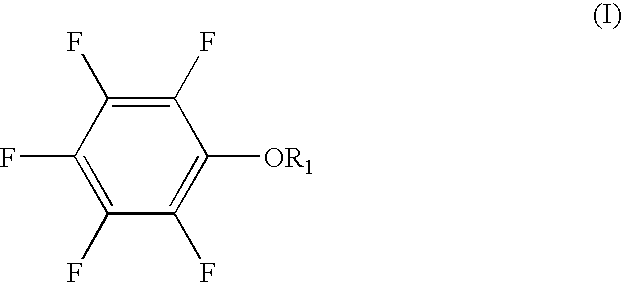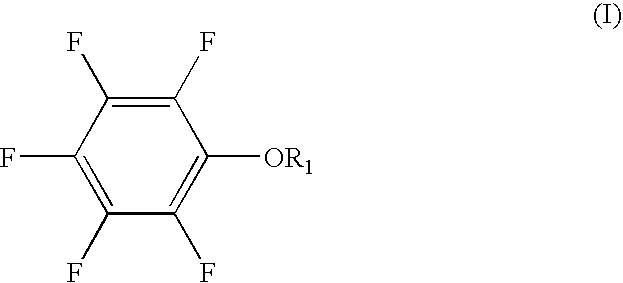Non-aqueous electrolytic solution and lithium secondary battery using the same
a technology of non-aqueous electrolysis and lithium secondary batteries, which is applied in the direction of non-aqueous electrolyte cells, cell components, electrochemical generators, etc., can solve the problems of not being satisfactory and 80% of the capacity retention of coin-shaped cells after 200 cycles, and achieve the effect of improving battery performance, particularly cycle characteristics
- Summary
- Abstract
- Description
- Claims
- Application Information
AI Technical Summary
Benefits of technology
Problems solved by technology
Method used
Image
Examples
example 1
(Preparation of Non-Aqueous Electrolytic Solution)
[0050]A non-aqueous solvent of EC:PC:MEC having a volume ratio of 30:5:65 was prepared. LiPF6 (electrolyte salt) was dissolved in the solvent to prepare a 0.9 M non-aqueous electrolytic solution. 0.5 wt. % of pentafluorophenyl methanesulfonate and 5 wt. % of vinylene carbonate were added to the non-aqueous electrolytic solution. The percentage was expressed based on the non-aqueous electrolytic solution.
(Preparation of Lithium Secondary Battery and Measurement of Battery Performance)
[0051]90 wt. % of LiCoO2 (active positive electrode material), 5 wt. % of acetylene black (conductive material), and 5 wt. % of polyvinylidene fluoride (binder) were mixed. 1-methyl-2-pyrrolidone (solvent) was added to the mixture. A surface of aluminum foil was coated with the resulting solution. The mixture was dried, molded under pressure, and heated to form a positive electrode.
[0052]95 wt. % of artificial graphite (active negative electrode material)...
example 2
[0055]An electrolytic solution and an 18650 battery were prepared in the same manner as in Example 1, except that 1 wt. % of pentafluorophenyl methanesulfonate and 2 wt. % of vinylene carbonate were added to the non-aqueous electrolytic solution. The battery performance was measured after 200 cycles. The retention of the discharging capacity relative to the initial discharging capacity was 85.1%. The conditions for preparation of the battery and the battery performance thereof are set forth in Table 1.
example 3
[0056]An electrolytic solution and an 18650 battery were prepared in the same manner as in Example 1, except that 1 wt. % of pentafluorophenyl methanesulfonate, 2 wt. % of vinylene carbonate and 0.5 wt. % of dipropargyl oxalate were added to the non-aqueous electrolytic solution. The battery performance was measured after 200 cycles. The retention of the discharging capacity relative to the initial discharging capacity was 86.6%. The conditions for preparation of the battery and the battery performance thereof are set forth in Table 1.
PUM
| Property | Measurement | Unit |
|---|---|---|
| wt. % | aaaaa | aaaaa |
| wt. % | aaaaa | aaaaa |
| temperature | aaaaa | aaaaa |
Abstract
Description
Claims
Application Information
 Login to View More
Login to View More - R&D
- Intellectual Property
- Life Sciences
- Materials
- Tech Scout
- Unparalleled Data Quality
- Higher Quality Content
- 60% Fewer Hallucinations
Browse by: Latest US Patents, China's latest patents, Technical Efficacy Thesaurus, Application Domain, Technology Topic, Popular Technical Reports.
© 2025 PatSnap. All rights reserved.Legal|Privacy policy|Modern Slavery Act Transparency Statement|Sitemap|About US| Contact US: help@patsnap.com



